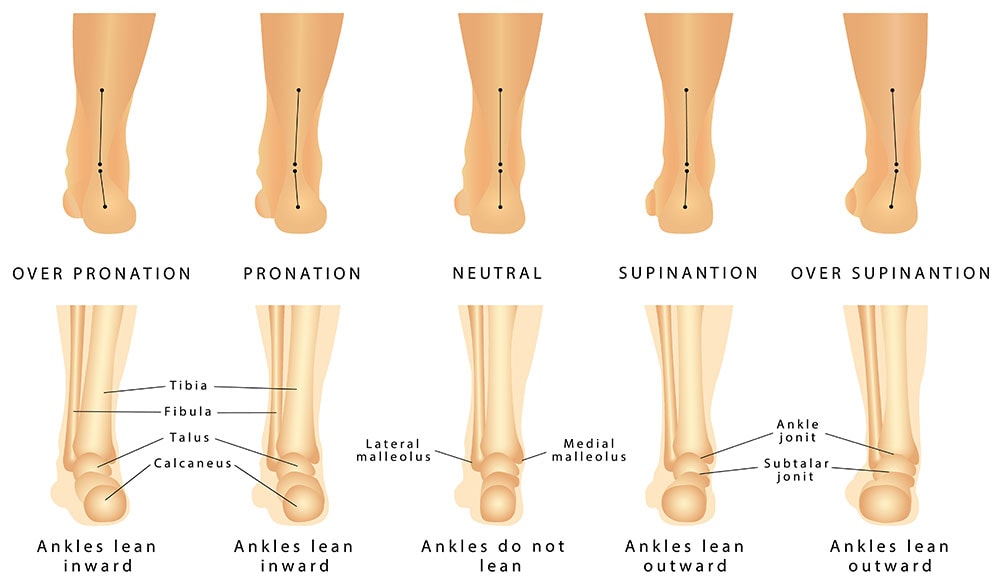Last week, we posted about overpronation, some common injuries that befall overpronators, and some methods of dealing with aches and pains and preventing injuries.
This week, we’re revisiting the topic of pronation to talk about the much less common condition, underpronation, also known as supination. If you recall, pronation refers simply to the rotational motion of the midfoot inward and downward, as the foot takes on the weight of the body with each step.

Some amount of pronation is required to adequately absorb the shock of walking and running. Underpronation is when the foot rolls inward too little. People who underpronate put more stress on the outer edges of their feet and, in extreme cases, this can cause problems.
Signs and Symptoms of Underpronation
Many of the signs of underpronation are similar to those of overpronation, including:
- Arch or heel pain.
- Pain that migrates from the feet upward, affecting the knees and lower back.
- Pain manifests after a long period of standing, walking, or running.
- Swelling in the mid-foot, the side of the foot, the heel, the ankle, and even toes.
- Stiffness and loss of range of motion in the feet.
Common Injuries of Underpronators
Underpronators tend to bear more weight during push-off on their outside toes and their pinky toe. Underpronators usually have high arches, and they can have tightened Achilles tendons which can result in overuse injuries, such as:
- Achilles tendinitis
- Plantar fasciitis
- Heel spurs
- Instability
- Iliotibial band syndrome. This is the inflammation of the IT band, the ligament running down the outside of the thigh that connects the hip to the shin. The IT band helps to stabilize the knee.
Treatment for Underpronation
Replace your shoes. Underpronators can see the signs of their condition on the soles of their shoes. The excessive stress will start to show on the outer edges of the shoes, wearing them out quicker than the rest of the sole.
If you exercise regularly, you should replace your shoes more often than your average runner. How to tell when you’ve worn them out: set the shoes on a table and check for outward tilt.
When you go shoe shopping, choose a lightweight, flexible sneaker. The extra flexibility will be able to meet the demands of greater motion on the inner edge. Make sure your shoes are comfortable, provide plenty of cushion for the heel, and have enough support for your high arches.
Use orthotic inserts. One way you can relieve pain without having to throw out all of your shoes is to use an orthotic insert. Your foot and ankle specialist can have a custom insert made just for the shape of your foot, or you can pick up inserts at a drug store.
You will want a pad that cushions your heel. You might be surprised to find how much this seemingly simple solution can help to ease your heel, knee, and lower back pain.
Foam rolling. Use a dense foam roller to loosen the IT band and the calves. Don’t rush the foam rolling. Spend extra time on the spots that feel tender – those are the tightest areas that need extra attention.
You can also get some relief by massaging the bottoms of your feet. While seated, use a tennis or lacrosse ball to roll out your plantar fascia.
Stretching. Stretch before and after working out to keep the tissue strong and flexible. Employ some of the same stretches that we recommended for overpronators, including:
- Ankle rolls
- Toe touches
- Toe and heel lifts
- Calf raises
- Crab crawls, targeting the ankles
Build leg strength. By working your midrange and upper leg muscles, you can relieve pressure on the IT band and reduce pain in the knee. You can try:
- Lunges (side lunges, lunge twists, and lunge dips as well)
- Squats
- Uphill walking or jogging
- Sprints
Managing Over- and Underpronation
Pain and injuries associated with over- or underpronation can be managed with these techniques, which can help to reduce muscle fatigue, distribute weight more evenly about the foot, and absorb shock.
Understand, however, that there’s very little that exercise and physical therapy can do to “fix” the underlying structural issue, short of surgery. Surgical correction of over- or underpronation is not typically performed except in the most extreme of cases. Be sure to exhaust all of your conservative, non-invasive options before considering surgery.
If you have questions about your foot and ankle care, we encourage you to call us at (877) 989-9110 or visit us at www.footankleinstitute.com.
- The Link Between Foot Health and Posture - April 14, 2024
- Why Are My Feet Different Sizes? It’s More Common Than You Think - March 27, 2024
- Custom Orthotics vs. Over-the-Counter Inserts: Which Are Best for Your Feet? - February 7, 2024
Be it Knee pain, heel pain, waist pain, back bone pain, ALWAYS treat the real root cause of your pain.
You are 100% correct on that point!